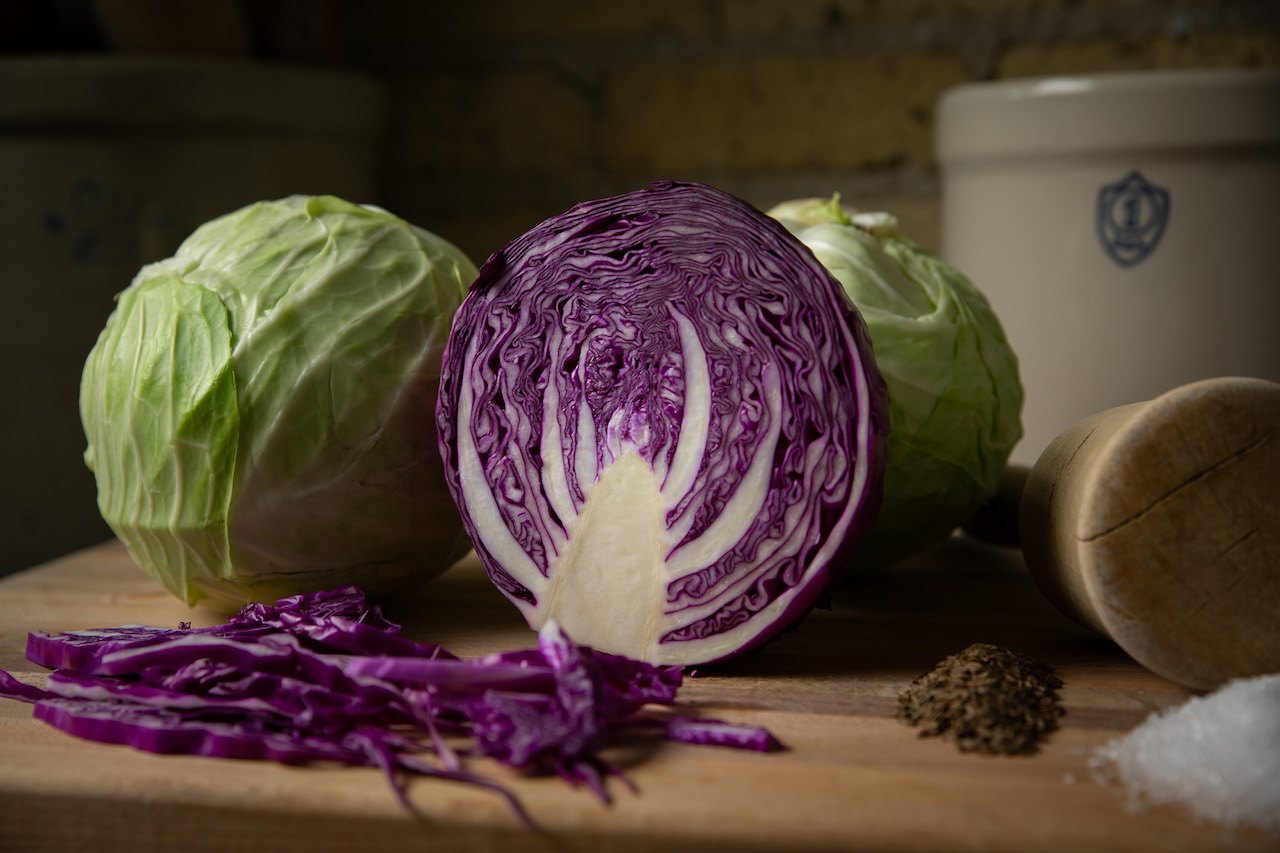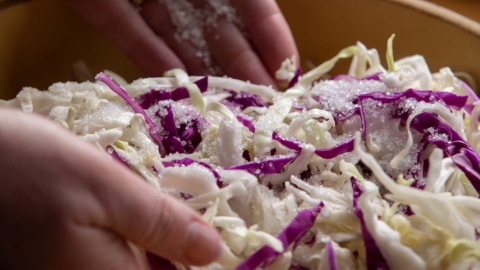Kraut Pleaser
Whether you call it sauerkraut or kapusta, fermented cabbage is a beloved delicacy in Milwaukee. Not too long ago, every family of Central and Eastern European descent kept a crock of fermenting cabbage tucked away in a dark corner. Making sauerkraut is a fun and easy beginning fermentation project that the entire family can participate in doing.
All fermentation, whether instigated by bacteria, yeast or mold, is chemistry and uses microbiology to create a changed state of a foodstuff to prolong its usability. At the most basic level, fermentation occurs when yeasts, bacteria or mold are attracted to sugared or salted fruits and vegetables and their respective byproducts raise the acidity of the food, which prevents other pathogenic microbes from invading.
Sauerkraut is the result of salted cabbage hosting a lactobacillus colony. Lactobacillus consumes carbohydrates and produces lactic acid as waste. This elegant and controlled ‘decay’ is the essence of all fermentation.
The most commonly used fermentation tool is the stoneware crock. Crocks come in various sizes, from one gallon up to 50 gallons. Crocks are ‘salt-glazed’ to seal the material and make it watertight. What makes a stoneware crock so useful for fermentation is its ability to hold foods at a steady temperature. Many a family has fought a battle over custody of Grandma’s crock, but in truth, modern crocks work very well and are readily available. You can also use food-grade plastic buckets as fermentation crocks. These can be purchased new or recycled from friendly restaurants and bakeries. I’ve found no difference in the quality of sauerkraut in using food-grade buckets versus stoneware crocks.
More important than the container is the ‘lid’ you put on top of it. For fermentation to be successful, the microbes must actively produce carbon dioxide, which needs to escape its container or it becomes pressurized. Best to have a lid that allows for the carbon dioxide to escape and prevent oxygen (and bugs and pathogens) from entering. Many contraptions have been invented to do just that. Stoneware crocks often come with a wooden lid, which allows gasses to move but does little to prevent pathogens.
A better solution for fermenting using crocks or buckets is the ‘Water Bag.’ Using a zipper seal plastic bag, fill it half full with water and add a tablespoon of salt. Seal it, then put it into another zipper seal bag. Rinse and place on top of your beginning ferment. The weight of the water keeps the material from floating, and the nature of the water is to level itself in the container; effectively creating an airtight barrier, but not so tight to prevent the carbon dioxide from escaping.
The water bag method also solves another challenge, keeping the food material below the fermenting liquid. Many families use the combination of a plate weighted down with a brick. My husband actually keeps his grandmother’s ‘pickle brick’ as a fond memory of her. ‘Pickle weights’ can be purchased in many diameter sizes to fit a variety of jars and crocks.
We also need to pay attention to the salt and water. The choices made here are essential to the success of krauting. If you don’t know much about your water quality, your best option is to use distilled water. Modern tap and well-water are chock-a-block with additives (both wanted and unwanted) that can sometimes interfere with a successful lacto-fermentation. That said, if you are lucky enough to have high-quality tap water, go ahead and use it. It’s best to use “pure” salt also. Canning salt, sea salt, kosher salt; it doesn't matter as long as the label says it’s pure salt. Table salt is problematic as it’s fortified with iodine and has additives to keep it from caking, both of which can cause clouding and discoloration of the kraut.
Check your baby sauerkraut every three days during active fermentation to ensure that nothing unwanted is happening in the crock. If something bad is going on, you can see it. The cabbage will turn gray and be disgustingly mushy. Sometimes you'll see a white mold-like substance bubbling on the surface; it's not mold but yeast. This is often called the scum. Having a yeast growth can adversely affect the flavor and quality of sauerkraut. Some people prefer to scrape the scum off and continue fermenting. On the other hand, if you see blue, green, pink or black mold, that's it; the party's over. Compost that batch and start over.
Deciding when your sauerkraut peaks and is ready for consumption is a subjective and personal measurement. After about three weeks of fermentation, kraut will start to look and smell, well, kraut-y. This is also the point where you need to decide what you’re going to do with all your kraut. Storing it in the fridge keeps the lactobacillus growth alive but slowed. If you put them into jars and process them, they'll last for a year in the pantry, but the lactobacillus is dead and the shreds less crisp. Freezing will retain the crispness but still kill the active beneficial bacteria.





